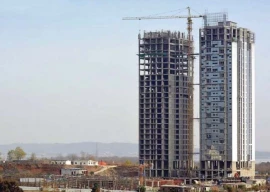
Oxfam GB, an international aid agency, is already running other programmes such as Land and Economic Opportunities, Ending Violence against Women, Disaster Risk Reduction and Climate Change in Sindh. The main focus of most of these projects is to ensure equitable access to quality education for girls living in rural areas of the country, particularly where evidence of violence against women is most found, said Dr Naureen Khalid, the programme manager of the girls’ education project.
Giving her presentation, she said the programme, already launched in four districts of the Punjab, has been extended to two districts of Sindh: Shahdadkot and Dadu. It aims to enhance enrolment and retention of students (especially girls) and restore access to quality education through rehabilitation of flood-affected and unaffected schools.
It has been expanded to Sindh in response to the abysmal situation of girls’ education particularly after the floods, said Dr Khalid. The literacy rate in Sindh is 47.2 per cent and women are only 20 per cent literate in the rural areas. Up to 105,588 girls were enrolled in schools in the province before the flood and after the calamity, the number decreased to 68,089, she informed the participants. According to Unicef’s damage assessment report, the number of damaged schools is the highest in Shahdadkot and Dadu, in comparison to other districts of the province.
The project that has been implemented by OGB and its local partners from January this year to December 2012 targets to make schools children-friendly, to sensitise all stakeholders for enhancing quality education and to enhance enrolment by 45 per cent and retention by 15 per cent.
Indus Resource Centre executive director Sadiqa Salahuddin said the dearth of female teachers is also a contributing factor for the decreasing female enrolment. Despite all government efforts, the rate of female enrolment in Sindh is only 22 per cent.
Dr Baela Raza Jamil, the executive director of the Idara-e-Taleem-o-Aagahi, called on the government to collaborate with NGOs and the civil society to scale up the efforts being made in the education sector.
Agreeing to Dr Jamil, Sindh education department deputy programme manager Naveed A Sheikh said, “After the floods, it is indeed time for us to work together. The set targets of the project can be achieved if the government unites.”
Talking about bottlenecks, he said public schools in rural areas have a low number of female teachers because of the low literacy rate.
“We don’t have many post-primary schools (secondary schools) in Sindh. According to available figures, out of the 49,000 schools in Sindh, hardly 4,500 are post primary. Out of these 40 to 50 are for girls, he said, asking the civil society and NGOs to intervene in this area.
Published in The Express Tribune, February 10th, 2011.

1725030039-0/Untitled-design-(2)1725030039-0-165x106.webp)




1614423942-7/-ET-Burns-Road-by-Athar-Khan-(8)1614423942-7-270x192.webp)










COMMENTS
Comments are moderated and generally will be posted if they are on-topic and not abusive.
For more information, please see our Comments FAQ